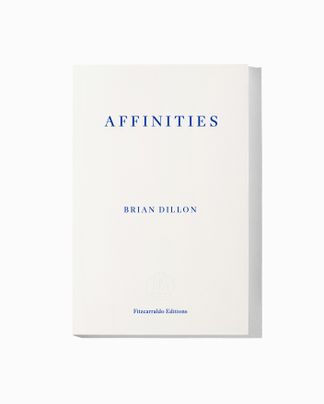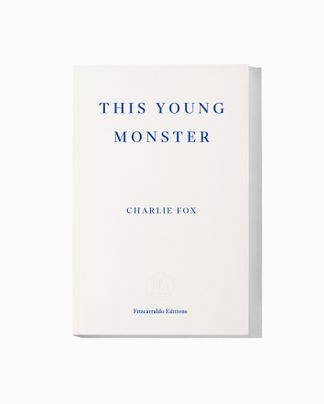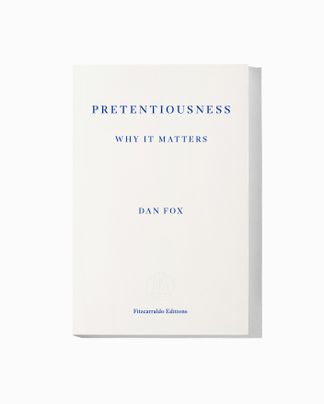When all else fails, when our compass is broken, there is one thing some of us have come to rely on: music really can give us a sense of something like home. With It Gets Me Home, This Curving Track, legendary music critic Ian Penman reaches for a vanished moment in musical history when cultures collided and a certain kind of cross-generational and ‘cross-colour’ awareness was born. His cast of characters includes the Mods, James Brown, Charlie Parker, Frank Sinatra, Elvis Presley, John Fahey, Steely Dan and Prince – black artists who were innovators, and white musicians who copied them for the mainstream. In ‘prose that glides and shimmies and pivots on risky metaphors, low puns and highbrow reference points’ (Brian Dillon, frieze), Ian Penman’s first book in twenty years is cause for celebration.

It Gets Me Home, This Curving Track
French paperback with flaps, 192 pages | Paperback, 192 pages
Published 14 August 2019
It Gets Me Home, This Curving Track
THE FAST BIRTH AND SLOW OEDIPAL DEATH OF ELVIS AARON PRESLEY
In the spring of 1965, on the road between Memphis and Hollywood, desert plains all around, his bloodstream torqued by a tinnital static of prescription ups and downs, Elvis Presley finally broke down. He poured out his troubles to Larry Geller, celebrity hair stylist and, lately, something of a spirit guide for Elvis. Geller had given him a mind-expanding reading list of what we would now recognize as New Age self-help books. Elvis had read them all, performed all the meditations, but didn’t feel the light, not in mind, body or soul. The fire refused to descend; his spiritual air remained a vacuum. Now, on the plush customized tour bus, Geller was thrown by how desperate Elvis seemed. Flailing, he fished out a Zen koan: ‘If you want tea, first empty your cup.’ (Tea? Empty cups? This was not the language Elvis spoke. His cup would require several lifetimes’ scouring.)
Later that afternoon, at a site near the Grand Canyon, everything tilted on its axis. Elvis grabbed Geller’s arm and pointed out of the bus at some distant clouds, shouting: ‘Look! There’s Joseph Stalin in the clouds! What is he doing up there?’ He had the bus stop, and ran into the desert. ‘Oh my God, Larry, follow me!’ Elvis was babbling, tears running down his face. He grabbed Geller, hugged him and said: ‘You’re right: you told me the truth. God is love.’ The sky had not turned the colour of cherry yoghurt, he didn’t hear night dogs howling at the sunlight, or the screech of messenger crows. Now that it had finally arrived, his vision was sharp and clear, trailing a flavour more of banishment than revelation – banishment and shame. Stalin, he thought, was a message about the Evil Elvis inside, his goatish ego. Stalin’s face dissolved into a knife-point pain in his heart, became a slow-motion explosion, became the face of Christ. This was clearly a defining moment: today and tomorrow would be as different as land and sky.
That evening, safe in his Bel Air rental (a Frank Lloyd Wright designed house previously owned by the Shah of Iran), he said to Geller: ‘I don’t want to perform any more. I want to leave the world. Find me a monastery. I want to become a monk.’ But his ascetic mood soon passed (as every Elvis mood passed, each brief and delicious horripilation), and the marker of this grand spiritual event became an order he put in to his personal jeweller for two hundred wrist watches that flashed both cross of Jesus and star of David. Such personal touches were far more Elvis than any of the books that had been recommended to him. Soon life would again be games with lascivious starlets and golden guns and awesome dune buggies. Soon he would be home again and primed for every day’s hijinks; soon it would be night again and every night’s endless waking sleep.
Elvis Aaron Presley was born on 8 January 1935 at around 4.30 in the morning, at home in East Tupelo. His older twin, Jesse Garon, was stillborn. (There was ugly gossip later that the doctor, William Robert Hunt, might have had a drink; that he might have saved Jesse if he hadn’t been so preoccupied with the surprise appearance of a second child. But the Presleys were satisfied with his work and Dr Hunt received his standard $15 payment from the county.) In many communities the arrival of twins was regarded as a queasy, unreadable omen. What to make of this mixed benison of one dead and one surviving lamb? Elvis was born into a puzzle, a world marked by loss from the start. From his first breath, life would always be a matter of missing echoes – conversations that could only be imagined, a partnership annulled before it could even begin – but for his deeply religious mother there was never any doubt: he was chosen, blessed, her own golden king.
All through the pregnancy, Gladys Presley had attended her local Baptist church, the Tabernacle of the Assembly of God. This was a Pentecostal faith in which the happy ordeal of being born again was called the ‘burning love’; speaking in tongues was considered a gift – variously known as ‘the barks’, ‘the jerks’ or ‘the Holy laugh’ – and parishioners were encouraged to rise and speak at any time, allowing God’s voice to pour out from within. Gladys was blessed with this ability, called ‘the comin’ through’. And that starry forcefield Elvis later stumbled into, where his raucous and playful spirit brought the whole world to his blue-shod feet – wasn’t that too a form of ‘comin’ through’? Gladys would live to see her boy-king ascend to heaven (or its earthly equivalent, the Ed Sullivan Show) but her own humbled body gave up the ghost in August 1958. In a family portrait taken two months earlier she looks absent, distracted. Her eyes seem to float out beyond the frame, as if she has already sighted the star-shape of death, felt some sharp feather of pain worse even than losing a child. ‘She’s my best girlfriend,’ Elvis sobbed on the white steps of Graceland when she was gone: ‘She’s all we lived for.’
Before she met Elvis’s father, she was Gladys Love Smith. Her mother was Octavia Luvenia Mansell, her great-grandmother was a Cherokee, Morning White Dove. These were stoical and wilful women; whereas the Presley men were not what you’d call an unmixed blessing. Elvis’s great-grandfather, Dunnan Presley Jr, was a two-time Civil War deserter. When he had to fill out a form for a government pension, he wrote: ‘I depend upon myself and do the best I can, which is bad.’ As Peter Whitmer puts it in The Inner Elvis (1996), ‘there was a history to the emptiness that flawed Vernon’s character and created the subsequent psychological hole in Elvis’s personality. Both the lack of and the need for a father figure seemed to be a Presley family tradition.’ Vernon Presley struck his neighbours as amiable enough, but not all there: a man of hollow promises, fundamentally unreliable. Sometimes he seemed to be little more than a lazy impersonator of his own cherished self-image – airy, cunning, one of life’s happy drifters. He ended up in the penitentiary, following a poor attempt at forgery. If he’d only been a tiny bit smarter, he might have made one hell of a con artist.
(…)
Guardian Best Books of 2019 | The TLS Books of the Year 2019
‘It Gets Me Home, This Curving Track summons the lives and times of several extravagantly damaged musical geniuses and near-geniuses in (mainly) the brutal context of mid-century America – its racial atrocities, its venality, its murderous conformities. Ian Penman writes an exact, evocative prose as surprising as improvised jazz in its fluid progress from music criticism to social commentary to biography and back. He’s found a way to be erudite without pedantry, entertaining without pandering. His ear for mesmerizing nuance is unmatched by any music critic alive.’
— Gary Indiana, author of Three Month Fever
‘Consistently told me stuff I didn’t know about stuff I thought I knew. No other ‘music writer’ combines such lightness of touch with such depths of diving.’
— John Jeremiah Sullivan, author of Pulphead
‘Ian Penman’s work has the tone, and the texture, and the complexities of the music and musicians he talks about, whether it’s Steely Dan laughing up their sleeves, the thorny declines of John Fahey and James Brown, or Elvis’s conflicted southern manners. It’s sharp and incisive but also full of love; it is beautiful writing.’
— Bob Stanley, author of Yeah Yeah Yeah
‘The eight pieces have a depth and expansiveness that transcend their origin as book reviews, several of them cannily commissioned by someone at the London Review of Books who saw his potential as a long-form essayist…. What gets us home, as it were, is Penman’s verve, and his eagerness to make us listen to the records as attentively as he does…. his essays on James Brown, Charlie Parker and Prince aren’t definitive; they are only inimitable.’
— Anthony Quinn, Guardian
‘At his best, Penman exemplifies the art of effective music criticism: neither comprehensive nor hagiographical, his portraits of pop-cultural figures have a unique richness.’
— K Biswas, New Statesman
‘Extensive and insightful’
— Musicradar
‘Penman’s subjects are a canny mixture of legend (James Brown, Charlie Parker, Frank Sinatra, Elvis, Prince), fascinating outlier (John Fahey, Steely Dan’s Donald Fagen), and movement (an unflinching unpicking of the continuing Mod revival). Many of these figures have been done to death, of course, but Penman confronts the spectre of biography-overload by referencing key works he admires, and some he doesn’t, fusing his own arguments with other writers’ missteps or apparent lapses in taste. It’s a tactic that benefits the reader, casting light on differing viewpoints and, as evidenced by both a bibliography and ‘discography/mood map’, signposting further recommended reading…. a book that so artfully marries history and criticism emerges as a joyous celebration of the complex act of writing about music.’
— Gary Kaill, The Quietus
‘Penman is not only adept at what the Frankfurt musicologist Theodor Adorno called ‘structured listening’, the ability to hold the totality of a musical work in mind while being minutely aware of its details at the micrological level, he is also acutely proficient at the sympathetic tone. The subjects of these essays may be consensual enough – Sinatra, Presley, James Brown, Charlie Parker, the Mods, and others – but there is not even a hint of playing to the crowd in their discussion. In this sense, it becomes genuinely beside the point whether the reader likes the artist in question or not, not because Penman takes anybody else’s response for granted, but because there are always things to learn, to notice, to smile about, when one sets one’s tribal affiliations to one side…. These truly are essays that, as the writer hopes, will reward periodic revisits. As somebody once crooned, nobody does it better.’
— Stuart Walton, Review 31
‘How – in Penman’s words – to be serious without being pompous, how to be simultaneously complex and seductive, how to give a hint of your own flaws and passions without being boorishly or presumptively autobiographical: such are the struggles of the high-end essayist-reviewer, and the tension at the heart of Penman’s own pieces, since he started writing them, as a teenager, for the 1970s NME. The years have made his writing clearer, deeper, sadder, richer. This is a wonderful collection.’
— Jenny Turner, author of The Brainstorm
‘Ian Penman is an ideal critic, one who invites you in, takes your coat, and hands you a drink as he sidles up to his topic. He has a modest mien, a feathery way with a sentence, a century’s worth of adroit cultural connections at the ready, and a great well of genuine passion, which quickly raises the temperature. Penman writes about the monuments of popular music as if he had a personal stake in them – which of course he does.’
— Lucy Sante, author of The Other Paris
‘Writing about music can often be a joyless and rather sterile exercise in point-scoring, fact-shaming and imposition of the party line, but rather than engage in musical vivisection, Ian Penman’s mercurial, teasing, provocative prose presents him as a tap dancer – one who happens to use his fingers instead of his feet, and a keyboard instead of a sprung floor. Whether you agree with everything he says is beside the point. What matters is that he aspires to make the same shapes and rhythms on paper as his subjects do with particles of air.’
— Will Ashon, author of Chamber Music
‘Ian Penman – critic, essayist, mystical hack and charmer of sentences like they’re snakes – is the writer I have hardly gone a week without reading, reciting, summoning to mind. The writer without whom, etc…. I was 15 when I first read Penman, and practically all I thought about was music. After Penman, I thought about language, too. About the ways a young life might be diverted by the wrong words, the wrong metaphors – how you might find the right ones in a stray song lyric or the corner of a magazine page…. The writing is frequently something entirely else: decades of love and listening translated into prose that glides and shimmies and pivots on risky metaphors, low puns, highbrow reference points…. I wouldn’t have written a word without the dream, ghost, echo of his writing.’
— Brian Dillon, frieze
‘Ian Penman is popular music’s Hazlitt – its chief stylist – and his sound is often equal to what he writes about. Each of his essays is an event, so this book is indispensable.’
— Andrew O’Hagan, author of The Secret Life
‘Written with love and joy and squirt gunner’s accuracy with the adjective.’
— Nicholson Baker, author of U & I
‘A laureate of marginal places.’
— Iain Sinclair, London Review of Books
Ian Penman is a British writer, music journalist and critic. He began his career at the NME in 1977, later contributing to various publications including The Face, Arena, Tatler, Sight & Sound, The Wire, the Guardian, the London Review of Books, Harper’s and City Journal. He is the author of the collections Vital Signs: Music, Movies, and Other Manias (Serpent’s Tail, 1998) and It Gets Me Home, This Curving Track (Fitzcarraldo Editions, 2019). His first original book, Fassbinder Thousands of Mirrors (Fitzcarraldo Editions, 2023), won the RSL Ondaatje Prize for Literature and the James Tait Black Memorial Prize for Biography in 2024.




